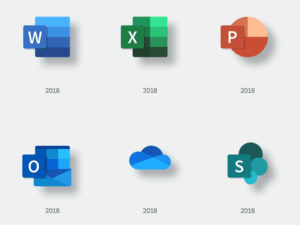I recently saw some cool tools that students can use to learn in different ways. It’s awesome to see what’s out there now, like gadgets, websites, and apps, all for free! They help teachers, students, and parents connect with each other. It’s amazing how much things have changed since I was in school.
Two notable competitors in the field of productivity suites, which are now essential in contemporary education, are Google Workspace and Microsoft 365. The way educators, students, and administrators collaborate, communicate, and interact in the digital age has been completely transformed by these platforms. Microsoft 365, a comprehensive suite of tools, offers a plethora of applications including Word, Excel, PowerPoint, Teams, and OneDrive. Because of its cloud integration, educators can easily create, distribute, and grade assignments. It also makes file sharing and editing effortless. Furthermore, Microsoft Teams has become a central location for online classes, hosting live lectures, panel discussions, and group projects from a single interface. Google Workspace has found its special place by offering easy-to-use online tools like Gmail, Google Docs, Sheets, Slides, and Drive. Teachers especially like Google Docs because it lets many people work on a document together at the same time, making collaboration a breeze. This makes it easier and more efficient for students to work on projects together and edit each other’s work. Google Classroom acts as a central hub for managing assignments, sharing news, and giving feedback, simplifying the process for both teachers and students. What makes Microsoft 365 and Google Workspace stand out is their focus on teamwork and communication. By using shared documents, calendars, and communication tools, educators can connect with their students outside of traditional classrooms. Students can access materials from any device, work together in real-time, and get instant feedback. As education moves into the digital age, relying on these productivity suites is not just convenient but essential for creating better learning environments.

When I make presentations, I use Microsoft Word, Google Docs, Google Slides, and Gmail. Microsoft Word helps me plan my ideas well because it has many useful features. Google Docs lets me work easily with others on group projects. Google Slides gives me lots of nice templates to make my presentations interesting. And Gmail helps me talk to my team and stay organized. Using these tools makes it easier for me to create good presentations and share them with others.
According to the article How Google Took Over the Classroom – The New York Times Productivity suites, exemplified by Google’s suite of educational tools, have revolutionized education by providing a multifaceted approach to enhancing teaching and learning experiences. These suites, including Google Classroom and Google Docs, facilitate collaboration among students in real-time, fostering teamwork skills and creating an interactive learning environment. Moreover, the accessibility and convenience offered by productivity suites enable students to access educational materials from anywhere with an internet connection, breaking down barriers to learning and seamlessly integrating technology into classrooms. The cost-effectiveness of Google’s educational tools, such as Chromebooks and free classroom apps, makes it feasible for schools with limited budgets to adopt technology, democratizing access to quality education. Additionally, productivity suites empower educators to innovate teaching methods, from flipped classrooms to personalized learning experiences, by providing tools for creating interactive lessons, delivering timely feedback, and efficiently tracking student progress. By streamlining administrative tasks like managing assignments and attendance, these suites free up teachers’ time to focus on instructional activities and student engagement. Ultimately, productivity suites play a pivotal role in preparing students for the digital age by equipping them with essential digital literacy skills and familiarity with technology platforms commonly used in professional settings, ensuring their success in an increasingly technology-driven world.
“Unlocking Educational Potential: Exploring Alternative Paths in Productivity Suites and Future Innovations”
Exploring alternative approaches to productivity suites in education involves considering open-source options and emerging technologies while speculating on their future evolution. Open-source productivity suites like LibreOffice and Apache OpenOffice offer cost-effective alternatives to proprietary suites, allowing educational institutions to reduce expenses and maintain control over their software infrastructure. These platforms provide similar functionalities to traditional suites, with the added benefit of flexibility and customization potential. Additionally, the integration of emerging technologies such as artificial intelligence (AI) and virtual reality (VR) holds promise for enhancing productivity tools in education. AI-driven personalization features could cater to individual learning needs, while VR simulations offer immersive educational experiences. Furthermore, collaborative platforms tailored to the needs of educators and students could emerge, incorporating project management tools, interactive whiteboards, and real-time collaboration capabilities. Accessibility and inclusivity will also play a crucial role in the future of productivity tools, with a focus on built-in accessibility features, support for multiple languages, and compatibility with assistive technologies. Tighter integration with learning management systems (LMS) is expected, streamlining workflows and facilitating data analytics for educators to track student progress effectively. By embracing these alternative approaches and anticipating future developments, educational institutions can better meet the diverse needs of learners and educators while fostering a more engaging and effective learning environment.
The article The History And The Future Of Cloud Office Suites elaborate that productivity suites, like Google’s set of educational tools, are really important for helping students learn important skills they’ll need for jobs in the future. Tools like Google Classroom and Google Docs let students work together on projects, talk to each other, and use technology easily. When students use these tools, they learn not just how to make documents and presentations, but also how to work as a team and share their work, which are super important skills for jobs nowadays.
Overall, productivity suites play a crucial role in modernizing education, improving teacher efficiency, enhancing student learning experiences, and fostering collaboration among all stakeholders involved in the educational process
